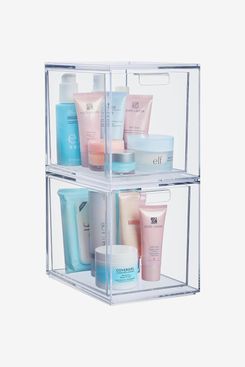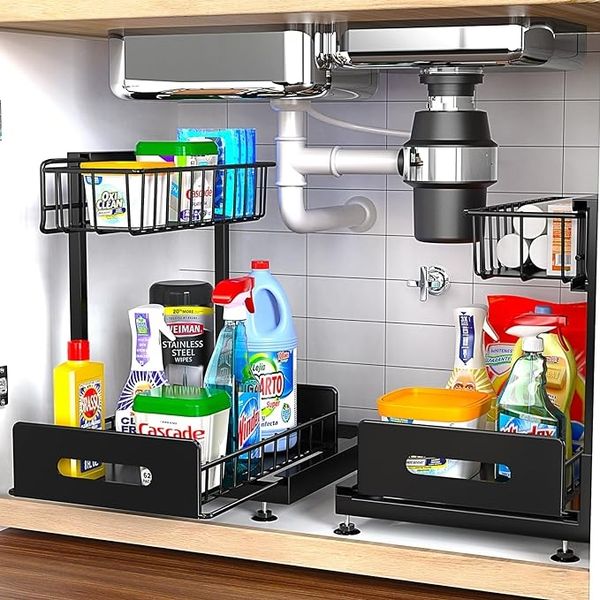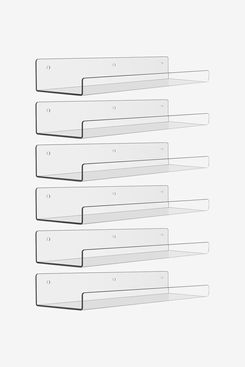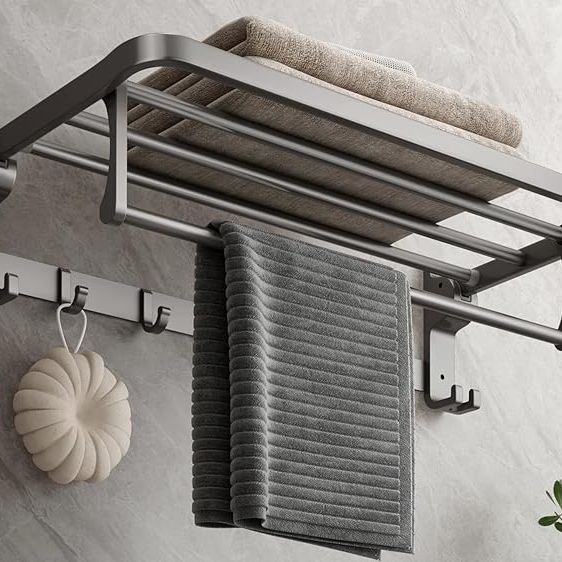
Maintaining an organized bathroom starts with keeping the space free of clutter, and professional organizer Ann Lightfoot, the co-founder of Done and Done Home, says the key is to “always organize a little so you’re never organizing a lot.” She points out that bathrooms are full of little things that get used up pretty quickly, and that “by keeping on top of empty bottles, throwing away expired makeup, your bathroom will stay organized and functional.”
One way she advises keeping clutter from taking over is to wipe down sinks and counters every day. Having to clear off surfaces and pick up bottles and tubes forces you to reckon with all those items taking up space. (And using disposable cleaning wipes or a launderable microfiber sponge can make this task less of a hurdle.) Daily maintenance, however, may not be enough to keep your collection of Sephora samples and almost-empty personal-care products from growing to an unreasonable size, so Lightfoot recommends a more in-depth declutter every three to four months or seasonally, not just tossing expired items, but also getting rid of anything that realistically isn’t going to get used. (Part of the decluttering process — the hardest part — is admitting to yourself that the tube of liquid highlighter you were so sure would change your life isn’t all that life-changing.)
Once you’ve edited down your things, instead of cramming them into the existing cabinets and drawers, Lightfoot recommends investing in small pieces that can double or triple available storage — and that will also set limits on all that stuff that wants to come in. We asked Lightfoot to pick out the go-to organizers she recommends to her clients, and the ones that she uses in her own home.
Update on August 27, 2024: Added note about restock notifications for the Over-the-Toliet Cabinet; updated prices and checked stock for all other products.
Because cabinetry can contain all your stuff and keep it hidden away, many people don’t think it’s necessary to organize their stuff into bins and containers under their sinks and in their drawers. But those smaller containers make it easier to find and retrieve what you need, and clear containers can help you see what you already have. No more excavating under piles of old makeup or skin-care products or having to pull out bottles of lotion and shampoo one at a time to try to find the hair dryer. To bring order to drawers, cabinets, vanities, or open shelving, Lightfoot likes this set of clear plastic trays.
Although you might be inclined to choose wooden or woven wicker bins or even metals ones for their look and feel, for stuff that’s going to be hidden within cabinet recesses anyway, opt for more practical, durable materials. “In the bathroom, we always recommend clear plastic bins that won’t be ruined by spilled products or water,” Lightfoot says. Size matters, too: She suggests using deep bins with handles for the space under the sink and small, shallower bins for wrangling the contents of drawers.
Establishing a dedicated place for makeup and skin-care samples sets a physical limit on how many of these tiny and irresistible items you can amass at any given time. Any bin or box will do (I use a Tiffany box for my trove), but going with a clear bin allows you to see your stash, offering a visual reminder to use that little packet of Sunday Riley moisturizer.
Modern architecture and design pose new organizational challenges. “In new builds, a lot of times there is storage under the sink, but it’s one large drawer and there’s no bigger area,” Lightfoot says. So we must add storage space back. In a small bathroom, “over-the-toilet shelves can radically change the amount of storage space available and make organization easier,” she says.
Editor’s note: This cabinet is currently unavailable, but you can check the product page for restock details.
When selecting an over-the-toilet unit, consider form and function. A storage cabinet should fit your aesthetic — but it’s even more important that it fits in your particular bathroom space. “Freestanding and wall-mounted units are both good options depending on your space and budget,” Lightfoot says. A wall-mounted cabinet like this one can make a small bathroom look less visually cluttered, but it may not be ideal if you’re a renter or don’t want to make any holes in the wall.
The space under the sink is valuable organizational real estate, but it can quickly turn into a black hole into which toilet paper and hotel shampoos disappear, never to be seen again. “We recommend adjustable organizing units that can be pulled out and act as drawers and can be configured to work around pipes,” Lightfoot says.
“If wall space is available,” Lightfoot says, “additional shelving can make all the difference, and there are a million different styles and materials to choose from. We love these clear acrylic floating shelves for things like nail polish and perfume.”
Among those million different styles is this set of sturdy floating shelves, which is ideal for holding bulky or heavy bathroom staples like extra towels, décor, or jars for cotton balls or Q-tips.
“Over-the-door adjustable organizers are great for people who don’t have the luxury of a large vanity or extra drawers,” Lightfoot says. “We recommend units that are plastic or metal, as opposed to fabric, for their sturdiness and waterproof materials.”
“There used to always be linen closets, so at least you could have a bin in there of back stock,” Lightfoot says, “but most homes don’t have linen closets anymore.” For stashing extra toilet paper or cleaning supplies, “we love narrow cabinets that can fit in tiny spaces next to the toilet or sink,” Lightfoot says.
Sometimes an obvious solution, like installing wall hooks, is the answer to your bathroom-clutter problems, “especially if you have kids who leave towels on the floor,” Lightfoot says. This set of hooks comes in many finishes that should match most fixtures. (For a less permanent option, you could always get Command hooks.)
To discourage members of your household from depositing their dirty towels or worse, their dirty underpants, on the floor, Lightfoot suggests placing a hamper in the bathroom if there is space available for it.
“Depending on where you store your towels, there are a few different options to keep them organized,” Lightfoot says. “If you store your extra towels in the bathroom, shelves and hooks are probably your best bet.” She picked this wall-mounted unit, which has space to both hang and to stack towels when not in use.
For those lucky enough to have dedicated space for storing towels and other household linens, Lightfoot says to invest in a set of shelf dividers. “If you have a linen closet, shelf dividers can work well to keep stacks from falling over,” she says.
Lightfoot calls this shower caddy “one of our all-time-favorite products for the bathroom,” for keeping shampoos, conditioners, body washes, poufs, scrubbers, and all other bath paraphernalia organized and off the floor or ledge of the shower or tub, where they will become gross. “It’s very difficult for bottles to stay dry if they’re on the floor, whereas with a caddy the water drains right off of it and then it air dries.”
The Strategist is designed to surface useful, expert recommendations for things to buy across the vast e-commerce landscape. Every product is independently selected by our team of editors, whom you can read about here. We update links when possible, but note that deals can expire and all prices are subject to change.




















